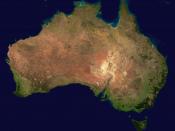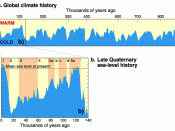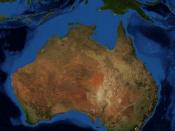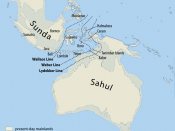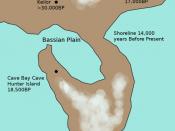Australia is an ancient landmass. The Earth is about 4600 million years old and the Australian continent is about 4300 million years old. Over many millions of years Australia has undergone many changes ÃÂ mountain ranges and inland seas have come and gone. As mountain ranges eroded, sediments many kilometres thick were laid down over vast areas. These sedimentary rocks were then subjected to folding, faulting and uplifting. Over time, the forces of weathering and erosion have worn these down again. Erosion acts more quickly on softer rocks, forming valleys and bays. Harder rocks remain as mountains, hills and coastal headlands.
Because it is located in the centre of a tectonic plate, rather than at the edge, Australia has no active volcanoes on its mainland and has very little tectonic lift from below. It therefore remains relatively quiet in terms of volcanoes and major earthquakes. This means its raised landforms, such as mountains, have been exposed to weathering for ces longer than those of some other continents.
Hence they are more rounded or worn down. In fact, Australia is the lowest and ïattest of all the continents. The present topography results from the erosion caused by a huge icecap, about 290 million years ago. After the ice melted, parts of the continent subsided and were covered by sediment to form sedimentary basins such as the GreatArtesian Basin.
÷ Australia is the continent with thelowest average elevation. The averagealtitude of the Australian landmass isonly 300 metres. North America has anaverage elevation of 790 metres.
÷ Only 0.5 per cent of the Australian continentis above 1000 metres.
AN ANCIENT LAND LOWEST AND FLATTESTDuring the last Ice Age, temperatures were much lower, and vast amounts of water became trapped in ice sheets and glaciers. The sea level was 100 metres lower than it is today. New Guinea and Tasmania were attached to mainland Australia. The climate was much colder in the south and much wetter in the centre. Temperatures in the inland were temperate to subtropical. There were great rivers and lakes, and lush vegetation teeming with bird and animal life. With the end of the Ice Age, about 15 000 years ago, higher temperatures led to the retreat of ice sheets and glaciers, and sea levels gradually rose to their present levels. Australia took on its present shape and became isolated, with Tasmania and New Guinea cut off from the mainland. Some of the lower valleys were drowned, making one harbours such as Sydney Harbour. As the sea level rose, other valleys îlled with alluvium, forming the typical lowland valleys around the Australian coast. Higher temperatures meant changes in climate, and the physical environment of the inland was transformed into the harsh desert and semidesert that we know today.
Sea levels have changed several times over thousands ofyears. About 18 000 years ago the sea level was at least120 metres lower than it is today. Yet if we look back asfar as 100 000 years ago, seas were only 20 metres lowerthan today.
http://www.about-australia.com/http://www.abs.gov.au/
